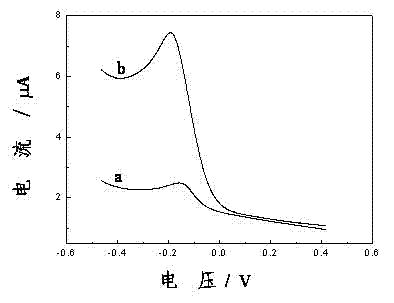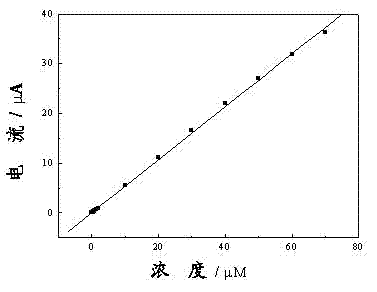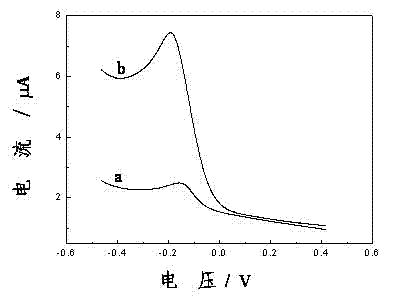Method for detecting phenol compounds by using horseradish peroxidase-modified electrode
A technology for horseradish peroxidase and phenolic compounds, which is applied in the field of electrochemical analysis and detection, can solve the problems of unsuitability for on-site detection, time-consuming operation, expensive instruments, etc., and achieves good biological activity, increased response current, and good stability. and reproducible effects
- Summary
- Abstract
- Description
- Claims
- Application Information
AI Technical Summary
Problems solved by technology
Method used
Image
Examples
Embodiment 1
[0018] Embodiment 1: This embodiment includes the preparation of modified electrodes (biosensors) and the determination of hydroquinone. The specific process is as follows:
[0019] (1) Pretreatment of the glassy carbon electrode: first, the glassy carbon electrode is coated with 0.05 mm Al 2 o 3 Polishing powder and suede are polished to a mirror surface, and then ultrasonically cleaned with distilled water, dilute nitric acid solution, absolute ethanol and double distilled water in sequence, and then used;
[0020] (2) Preparation of an alumina nanoparticle / chitosan / horseradish peroxidase composite membrane-modified electrode (biosensor): First, weigh an appropriate amount of chitosan and dissolve it in 0.1 M acetic acid solution and sonicate at room temperature 2 h to get 0.2% -0.6% (w / v, mg / ml) chitosan solution, the appropriate amount of alumina nanoparticles dispersed in 1 mL of 0.2% -0.6% (w / v, mg / ml) shell Glycan solution and sonicate until homogeneous. Prepare 6-10...
PUM
 Login to View More
Login to View More Abstract
Description
Claims
Application Information
 Login to View More
Login to View More - R&D
- Intellectual Property
- Life Sciences
- Materials
- Tech Scout
- Unparalleled Data Quality
- Higher Quality Content
- 60% Fewer Hallucinations
Browse by: Latest US Patents, China's latest patents, Technical Efficacy Thesaurus, Application Domain, Technology Topic, Popular Technical Reports.
© 2025 PatSnap. All rights reserved.Legal|Privacy policy|Modern Slavery Act Transparency Statement|Sitemap|About US| Contact US: help@patsnap.com



